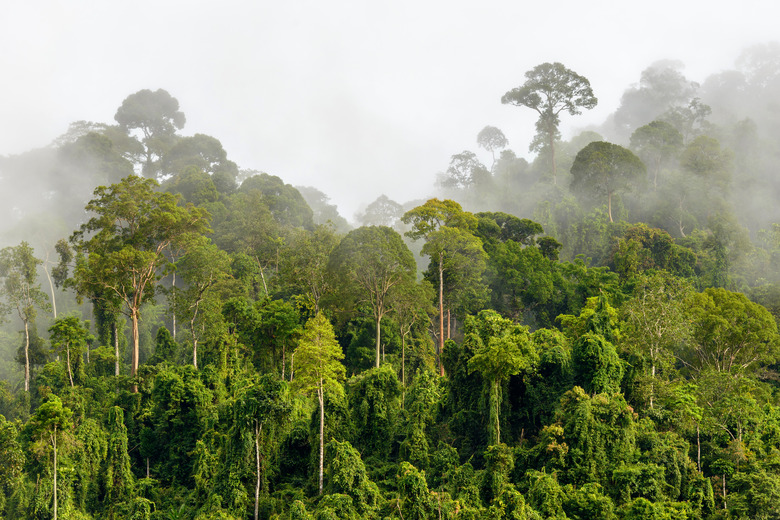How Does The Climate Affect The Ecosystem Of The Rainforest?
Tropical rainforests cover more than 30 million square kilometers. Temperate rainforests add another 300,000 square kilometers (116,000 square miles). Those numbers sound large, but they represent only about 6 percent of the Earth's surface – yet the rainforests supply more than 40 percent of the Earth's oxygen and contain more than half of the planet's biomass. Those are reasons enough to want to understand the climate and ecosystem of the rainforest.
TL;DR (Too Long; Didn't Read)
Every ecosystem is intricately tied to its climate. Rainforest trees take advantage of the climate's constant and plentiful supply of water to stretch ever higher. Their high branches then create a shady damp environment below – a climate that other organisms then adapted to. Temperatures affect the rainforest as well. Where a typical temperate forest will have only a dozen or two large tree species in a span of two acres, the tropical rainforest will have more than 200 distinct tree species in that same area. The same kind of diversity is displayed in other categories as well: reptiles, amphibians, birds and insects.
Rapid climate change could affect the rainforest by increasing the temperature and driving animals to regions farther away from the equator with cooler temperatures but greater seasonal swings they must adapt to, while organisms that remain in the rainforests either adapt to the higher temperatures or die out.
Climate and Ecosystem
Climate and Ecosystem
Every ecosystem is intricately tied to its climate. The only organisms that can thrive in any particular climate are those that have evolved to fit the specific blend of temperature, moisture, seasonal variations and other elements of that climate. In turn, the organisms within an ecosystem help create the climate. In the rainforest, for example, trees take advantage of the climate's constant and plentiful supply of water to stretch ever higher. Their high branches then create a shady damp environment below – a climate that other organisms then adapted to.
Temperate and Tropical Rainforests
Temperate and Tropical Rainforests
Two-thirds of the world's temperate rainforests are along the Pacific Northwest coast of North America. Those forests and their counterparts in New Zealand, China and Australia receive 150 to 500 centimeters (60 to 200 inches) of rainfall each year. Tropical rainforests get 200 to 1,000 centimeters (80 to 400 inches) in a year. Tropical rainforest climates have little to no seasonal variation, while temperate climates usually have four seasons.
Both tropical and temperate rainforests are characterized by tall trees that create a canopy well above the ground. Some plants have adapted to the climate beneath the canopy by growing as epiphytes, which means they grow on the branches or trunks of the larger trees. Another similarity between tropical and temperate rainforests is the way in which the nutrient cycle depends upon the decomposition of dead plant material that falls to the ground.
Uniqueness of Tropical Rainforests
Uniqueness of Tropical Rainforests
The huge amounts of rainfall, the lack of seasonal variation and the high temperatures of the tropical rainforest climate combine to encourage the growth of the most diverse ecosystems on Earth. Where a typical temperate forest will have only a dozen or two large tree species in a span of two acres, the tropical rainforest will have more than 200 distinct tree species in that same area.
The same kind of diversity is displayed in other categories as well: reptiles, amphibians, birds and insects. All of the unique climate elements of the tropical rainforest lead to a unique ecosystem.
Climate Change and The Tropical Rainforest
Climate Change and The Tropical Rainforest
You can't point to one single climatic factor responsible for the incredible biodiversity of the tropical rainforest climate. You can say, however, that rainforest creatures are now adapted to fit each aspect of their environment. For example, in a scenario of rapid climate change, the temperature of the rainforest might increase and force some of the organisms to move away from the equator to stay within their optimum temperature range. But the further they move from the equator, the more seasonal change – and greater temperature swings – they would encounter.
Meanwhile, species in that scenario that remained where the temperature is constant throughout the year would be faced with the necessity of adapting to higher temperatures or perishing. One way or another, rapid climate change sets up a race between the pace of evolution and the rate of change of the environment.
Cite This Article
MLA
Gaughan, Richard. "How Does The Climate Affect The Ecosystem Of The Rainforest?" sciencing.com, https://www.sciencing.com/climate-affect-ecosystem-rainforest-22138/. 27 April 2018.
APA
Gaughan, Richard. (2018, April 27). How Does The Climate Affect The Ecosystem Of The Rainforest?. sciencing.com. Retrieved from https://www.sciencing.com/climate-affect-ecosystem-rainforest-22138/
Chicago
Gaughan, Richard. How Does The Climate Affect The Ecosystem Of The Rainforest? last modified August 30, 2022. https://www.sciencing.com/climate-affect-ecosystem-rainforest-22138/
